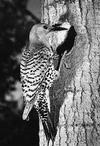- flicker
-
flicker1
—flickeringly, adv. —flickery, adj./flik"euhr/, v.i.1. to burn unsteadily; shine with a wavering light: The candle flickered in the wind and went out.2. to move to and fro; vibrate; quiver: The long grasses flickered in the wind.3. to flutter.v.t.4. to cause to flicker.n.5. an unsteady flame or light.6. a flickering movement.7. a brief occurrence or appearance: a flicker of hope.9. Ophthalm. the visual sensation of flickering that occurs when the interval between intermittent flashes of light is too long to permit fusion.[bef. 1000; ME flikeren (v.) OE flicorian to flutter; c. D flikkeren]flicker2/flik"euhr/, n.any of several American woodpeckers of the genus Colaptes, having the underside of the wings and tail brightly marked with yellow or red and noted for taking insects from the ground as well as trees.[1800-10, Amer.; said to be imit. of the bird's note]
* * *
Any of six species of New World woodpeckers (genus Colaptes) noted for spending much time on the ground eating ants.The sticky saliva of the flicker is alkaline, perhaps to counteract the formic acid that ants secrete. Its bill is more slender than that of most woodpeckers and is slightly down-curved. Most flickers have a white rump, black breast band, and varied head markings, and most are about 13 in. (33 cm) long. Yellow-shafted flicker (Colaptes auratus)B.M. Shaub
Yellow-shafted flicker (Colaptes auratus)B.M. Shaub* * *
▪ birdany of several New World woodpeckers of the genus Colaptes, family Picidae (q.v.), that are noted for spending much time on the ground eating ants. The flicker's sticky saliva is alkaline, perhaps to counteract the formic acid that ants secrete. Its bill is slenderer than in most woodpeckers and is slightly down-curved. The six species—most with a white rump, black breastband, and varied head markings—include the yellow-shafted flicker (C. auratus) of eastern North America, which has more than 100 local names. This golden-winged form, which measures about 33 cm (13 inches) in length, is replaced in the West (to Alaska) by the red-shafted flicker (C. cafer), considered by many authorities to represent the same species as the yellow-shafted because the two forms hybridize frequently. The campos, or pampas, flicker (C. campestris) and the field flicker (C. campestroides)—sometimes considered to be a single species—are common in east-central South America; they are darker birds with yellow faces and breasts.* * *
Universalium. 2010.
